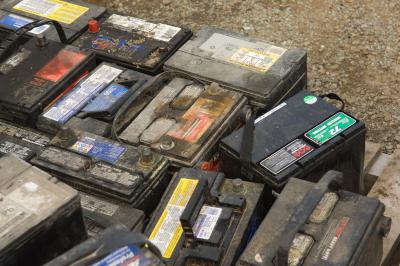
The first wet-cell battery -- the type used in automobiles -- appeared around 1866 when Georges Leclanche patented his battery, which used crushed manganese dioxide-carbon and a zinc rod. Modern automotive batteries use a series of lead plates and an electrolyte made up of diluted sulphuric acid to create the chemical reaction needed to store energy. Over time, your car's battery may develop a layer of white corrosion, which may cause electrical problems.
When you turn on the ignition to start your vehicle, the engine should crank over at its normal rate immediately. A slow start is when the engine's cranking speed is much slower than usual. This slow cranking is the sign of a battery with a low charge or affected by corrosion. Corrosion causes this condition by creating excessive resistance between the battery cables and the battery terminals.
Over time, the corrosion on the battery becomes thicker. If the corrosion is thick enough, this may cause the engine's cranking speed to slow to the point that the engine will not start at all. A clicking sound sometimes accompanies this condition.
Though the alternator provides most of the electricity needed to run the lights while the vehicle is running, the battery still plays a key role. The battery completes the circuit to the lighting system and corrosion creates resistance in this circuit, which causes the interior and exterior lights to dim. The lights continue to dim more as you turn on more electronic accessories -- radio, windshield wipers, etc.
On electronically controlled vehicles, the battery plays a key role in the electronic controls. If the battery has excessive corrosion, the electronic components may not receive the amount of voltage needed to function correctly. This can cause many running issues, including, but not limited to: rough idle, misfiring, poor fuel economy or harsh transmission shift.
Many times, this lack of voltage may also lead to a "check engine" light. The code stored in your vehicle's computer may read that the component has failed, but eliminating the corrosion will fix the problem.
Eliminating corrosion on your vehicle's battery is fairly easy. Use a metal-bristled brush, clean the thick corrosion off the battery terminal and cable end. Loosen the negative battery cable and pull it off -- if it doesn't pull off easily, use a battery terminal puller. Remove the positive cable in the same manner you did with the negative cable.
Spray the battery terminals with a battery terminal cleaner and use a battery terminal brush to clean the terminal. Spray the battery cable ends with the terminal cleaner and scrub them with a battery terminal brush. Wipe the terminals and cable ends off with a clean, lint-free cloth.
Place the positive battery cable back on the positive battery terminal and tighten it with a combination wrench. Set the negative battery cable on the negative battery terminal and tighten it with a combination wrench. Spray the battery cable ends with an anti-corrosive coating and allow the coating to dry for the time specified in the chemical's instructions.